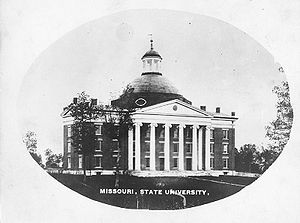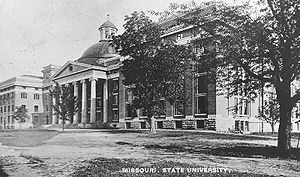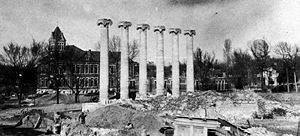
Academic Hall
Encyclopedia


University of Missouri
The University of Missouri System is a state university system providing centralized administration for four universities, a health care system, an extension program, five research and technology parks, and a publishing press. More than 64,000 students are currently enrolled at its four campuses...
. It was dedicated in 1843 and destroyed by fire in 1892. Academic Hall's six Ionic columns stand as the most recognizable symbol of the University of Missouri.
History
Academic Hall was built between 1840 and 1843 from plans drawn by Stephen HillsStephen Hills
Stephen Hills was an architect notable for designing the original Pennsylvania State Capitol.- Early life :...
, designer of the Missouri State Capitol
Missouri State Capitol
The Missouri State Capitol is located in the U.S. state of Missouri. Housing the Missouri General Assembly, it is located in the state capital of Jefferson City at 201 West Capitol Avenue. The domed building was designed by the New York architectural firm of Tracy and Swartwout and completed in 1917...
. The building was dedicated in 1843. It consisted of a domed central section of three stories, with two wings that were added in 1885, and housed both educational and administrative facilities. Brick for the building was fired on campus, and limestone for the Columns was obtained from the nearby Hinkson Creek Valley and was hauled to the building by ox-drawn carts.
Civil War
The role of the University of Missouri in the American military began in 1862, during the American Civil WarAmerican Civil War
The American Civil War was a civil war fought in the United States of America. In response to the election of Abraham Lincoln as President of the United States, 11 southern slave states declared their secession from the United States and formed the Confederate States of America ; the other 25...
. Missouri was a border state, and Columbia was a town that had many citizens of southern ancestry, so the university area fell under the eye of the federal government. During the war, a number of different Federal regiments were stationed in Columbia and billeted in University buildings. Academic Hall was used to house soldiers, and Union troops interned Confederate prisoners in the main library on the third floor of Academic Hall. Classes were suspended for 10 months because of the troop occupation and because of loss of staff due to the conflict. During the Union occupation of the library, 467 volumes were taken to construct fires. The Union troops caused other destruction on campus as well, and the Board of Curators, with Congressman James S. Rollins
James S. Rollins
James Sidney Rollins was a nineteenth century Missouri politician and lawyer. He helped establish the University of Missouri, led the successful effort to get it located in Boone County, and gained funding for the University with the passage of a series of acts in the Missouri Legislature...
as their representative, sued for damages. The U.S. government settled the case in 1915, the award was used to build the Memorial Gateway.
Fire of 1892



